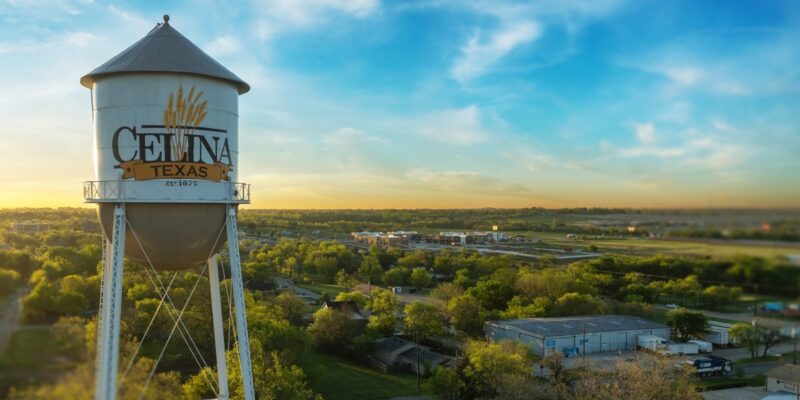
When Suzanne D’Amico moved from Dallas an hour north to Celina, Texas, there was one grocery store, longhorn cattle down the road and no lights on the horizon at night. Farmers wearing overalls gathered for morning coffee, teenagers packed the local pizzeria after Friday night football games, and neighbors prayed together at church on Sunday.
“It felt like we were on another planet,” said D’Amico, who has lived for nearly 30 years in Celina where she raised her children. “We weren’t just outside the city, we were completely gone from anything we considered at the time remotely civilized.”
But D’Amico’s slice of small town America is quickly vanishing. Like rural communities across the country, Celina is seeing a housing boom that made it America’s fastest growing city in 2023. Now, pastures have been replaced with densely packed homes, golf carts zip around planned communities where tractors once plowed and local businesses are being replaced with big box chains.
While the expansion of the suburbs is nothing new, a surge in home prices over the past several years has supercharged the trend, pushing homebuyers across the country further out from city centers to areas like Celina where land is cheaper and more plentiful and local barriers for developers tend to be lower.
Since the start of the pandemic, the population in rural areas has been growing for the first time in at least a decade, a U.S. Department of Agriculture analysis found. Among the 500 fastest growing cities in the country, the number of those more than 30 miles from a city center increased by 26% between 2019 to 2023, according to Census figures.
At the forefront of that trend is Celina. Its population increased by 27% in 2023 and over the past decade the town has gone from around 7,000 residents to more than 43,000 last year, according to Census data. With more than 200 people moving there each week, the city projects it will have more than 100,000 residents by 2029.
“For families that are moving now, affordability is a huge factor,” said Celina Mayor Ryan Tubbs, who said the town has been attracting people from higher-priced parts of Dallas as well as more expensive states like California. “The amount of house that you can get goes a lot farther.”
For those coming to Celina, which is about 40 miles north of Dallas, the development boom has provided a refuge from soaring housing prices, allowing newcomers to have the suburban lifestyle they are seeking at a lower cost than they could find elsewhere. But for some longtime residents, the migration has meant a loss to their sense of community, higher costs and a threat to their livelihoods.
A shortage of undeveloped land in the Dallas area has pushed builders further north into Collin County, which includes Celina and other fast growing communities like Princeton, Prosper and Anna. There, homebuilders are selling 2,000-square-foot homes for $400,000 to $500,000 compared to $700,000 to $1 million for a similar home in suburbs closer into downtown Dallas, said Bryan Swindell, president of PulteGroup’s Dallas Division.
“Southern Collin County is just getting really, really, really expensive. Places like Frisco, McKinney, they just have no more large pieces of land so builders have started working north,” said Swindell. “When a piece of land comes on the market there’s 10 developers and builders bidding on it.”
Most of the new developments being built are master-planned communities with more than 1,000 tightly packed homes, a scale that makes the construction process more economical for builders. Many of the communities have their own self-contained amenities, like pools, parks, biking trails, playgrounds, and in some cases, their own school.
The big box retailers and chain stores are following the migration. The town will get its first Walmart and Costco in the coming months and last year it got its second Starbucks.
While Celina has been racing to keep up with the pace of growth, the nearby town of Princeton, Texas, the third fastest growing city in the country, put a hold on all new residential development in September to give the city time to expand its water and roadway infrastructure and build up the necessary police force.
‘It’s happening’
For LaCinda Russell, the growth has come at a loss. Her family has lived near Celina for three generations, but after home prices in the region increased more than 50% over the past five years she doesn’t expect to ever be able to afford her own home there. She’s been living with her best friend in the house her friend’s family built more than two decades ago — a place that now feels like an island of familiarity in a sea of change.
Outside her window, a large crane is putting in a well on land that she expects to become a subdivision once the elderly woman who has owned it for decades passes away. The town recently lost the pizzeria where her classmates used to gather after football games along with a popular snow cone stand and burger joint off the town square.
“I’ve seen businesses come and go. I’ve seen people come and go,” said Russell. “Sentimentality dies when you cannot afford to maintain that lifestyle, and that’s a lot of what we’re seeing around here. People that have owned land for hundreds of years around here are having to let it go.”
That growth has also threatened those trying to make a living off the land, which has some of the country’s best soil for farming and cattle grazing. Collin County lost 115,000 acres of farmland between 2012 and 2022 and the number of farms with more than 500 acres has been nearly cut in half over that time, according to USDA data. Nationwide, the country lost 35 million acres of farmland over that period.
“North Texas is some of the most fertile soil in the country, that’s why Dallas is where it’s at and we’re building houses and developments on top of it,” said Kelcey Kasper, a sixth-generation rancher whose family has been in Collin County since the 1860s. “They’re not making any more land so eventually, if we keep building like we are, there won’t be any land for ag production. We’ll have to rely on somebody else for our food. I think that’s a really scary future.”
Kasper currently raises cattle and grows hay about 30 miles east of Celina, but he fears the growth happening there will soon be coming for his community and jeopardizing his ability to keep the family tradition going. Most farmers and ranchers in the area have to lease their land from investors or developers, who have been buying up properties over the past decade.
“I intend to live here for as long as I can, but I may not always be able to run livestock here and farm here, because the property values are going up,” Kasper said. “It’s hard being able to still make a living out here because the land is going away.”
But that loss is a gain for newcomers like Jasmine Hughes. She is among those who flocked to the area looking for a more affordable life for her and her six children. When she was living in Dallas, her rent was $1,900 a month for a two-bedroom apartment and she struggled to find anything in her price range with more space. Now, she’s renting a three-bedroom house in a sprawling subdivision for $2,500 a month with better schools and more outdoor space.
“I just needed something that was more affordable,” said Hughes, who moved to the area last year. “That is why we moved out here. It’s more realistic to get into a three or four-bedroom house so that me and my kids can all sleep and live comfortably.”
In just the past year, the main road outside her subdivision has added a Starbucks, a McDonald’s, a carwash and dentist office. She sees that growth as a professional opportunity — she runs a daycare that she is hoping to expand and has started teaching fitness classes.
“I feel excited about it, I just see so much opportunity for me and my family,” Hughes said. “I do hear some of the people who’ve lived here not wanting Celina to change that much, which I do understand, but it’s happening.”
Local officials are seeing no slowdown in growth, which has presented a range of logistical challenges. The city is proposing $757 million in projects over the next five years, including new parks, water infrastructure and an emergency dispatch center. The school district plans to add one to two new elementary schools each year for the foreseeable future.
Keeping Celina relatively affordable has also been a challenge for local officials with the typical home now selling for around $550,000. As land prices go up in Celina, developers like Plute’s Swindell are looking even further north to be able to build homes in the $300,000 price range.
‘A mixed blessing’
Luke Thigpen moved to Celina in 2019 to start a church and has been renting while trying to save up to buy a home for around $400,000. But it has been a challenge as home prices have continued to rise year after year.
He sees the growth as an opportunity, especially when it comes to expanding his congregation, but he worries about the tensions a wave of newcomers could create in a community known for having a strong tradition of Christian values.
“People see diversity coming in and they automatically put their guard up. They want to protect what they find are good values in life and that’s understandable,” Thigpen said. “You have other cultures that are moving in and it’s just simply an understanding that some people see the world differently, some people celebrate life differently and you have to make room for that.”
For D’Amico, after nearly three decades in Celina, she’s seen both pros and cons from the growth. Her husband’s construction business has thrived and the value of the land they’ve purchased over the years has soared.
“We’ve seen full fields of five-foot tall sunflowers, full fields of winter wheat, head-high corn and it’s hard to see it gone now,” she said. “My husband is a builder so it’s kind of a mixed blessing for us, but I do hate to see the fields go away.”
A 2,500-acre ranch down the road from her home was recently sold to a developer who plans to put thousands of housing units on it. Soon, a thoroughfare will be cutting through the open land 500 yards from her back fence.
“I know it’s going to kill my silence, the quietness around my house,” she said. “I’ve had 27 years of it, so I can’t really complain, but it has become very precious to me now.”















